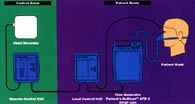
CPAP sleep apnea control
1981
machine to maintain breathing during sleep
Snoring kills some people! Many people have a condition called obstructive sleep apnea, which means that the muscles at the back of their mouth relax too much while they sleep, blocking their airways. They snore, stop breathing, choke, wake up then start snoring again, hundreds of times a night. In the daytime they are sleepy and irritable. As a result of oxygen deprivation during the night, they may suffer memory loss, high blood pressure, heart attacks and strokes. It is estimated that up to 24% of males and 9% of females aged 30 and over suffer from some degree of sleep apnea.
At the sleep clinic of the Royal Prince Alfred Hospital in Sydney, Professor Colin Sullivan devised a machine that keeps the airways open by blowing pressurised air through a nose mask. His Sullivan Nasal CPAP (continous positive airway pressure) was the first machine to give complete relief from sleep apnea. The machine was improved to make the flow rate and pressure adjustable to meet individual needs. The sleeping mask was also constantly redesigned to make it much more comfortable. Now sleep apnea sufferers can sleep soundly and enjoy better quality of life.
The ResCare company, later known as ResMed, was formed in 1989 to manufacture and market the CPAP. By the end of the century, ResMed operated through offices in the United States, Australia, Germany, France, Sweden, the United Kingdom, New Zealand, Singapore and Malaysia, and through a network of distributors in more than 40 other countries. Its main manufacturing base was in Sydney and the company spent 7-8% of its net revenues on research and product development. The company was listed on both the Australian and New York Stock Exchanges and had a total of 186 patents issued and pending for a range of technologies. In 2000 ResMed made the Forbes 200 Best Small Companies in America list for the fourth year in a row.
Who Did It?
Key Organisations
ResCare Limited : initial R&D, manufacture and marketing
University of Sydney : initial development
Royal Prince Alfred Hospital : initial development
Key People
Colin Sullivan : inventor
Peter Farrell : project manager, CEO of ResMed
Further Reading
'A device to beat snoring'
Peter Roberts
Australian Financial Review, 7 July 1992, p 24.
Links
ResMed Ltd. You can work out
your level of sleepiness!
Sleep Disorders
Australia
American Sleep Apnea Association
ATSE,
Sleep disordered breathing and ResMed
|











